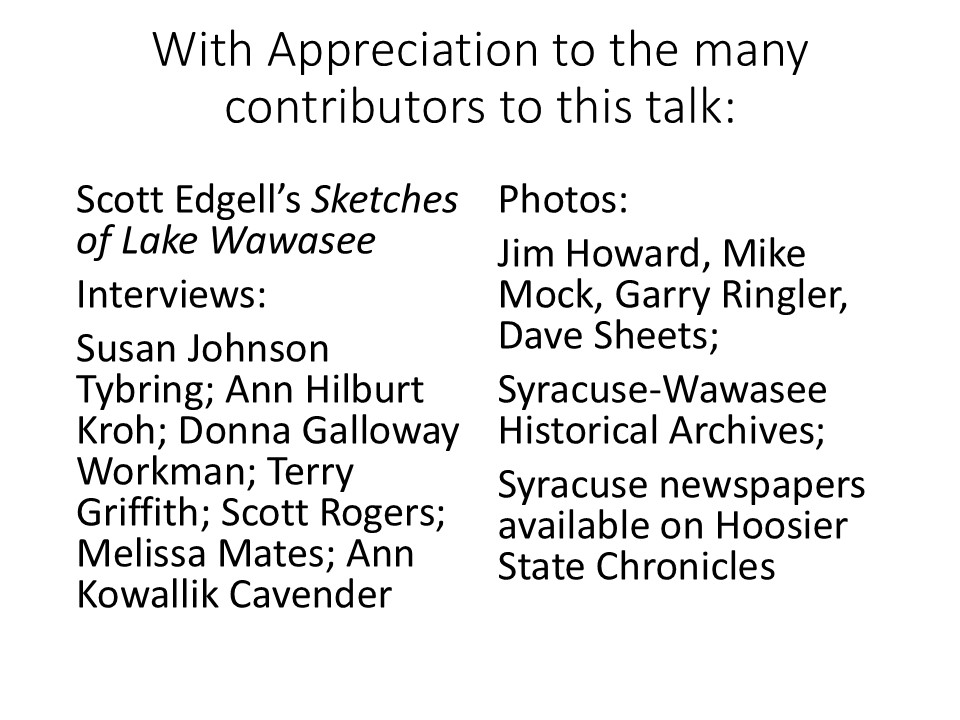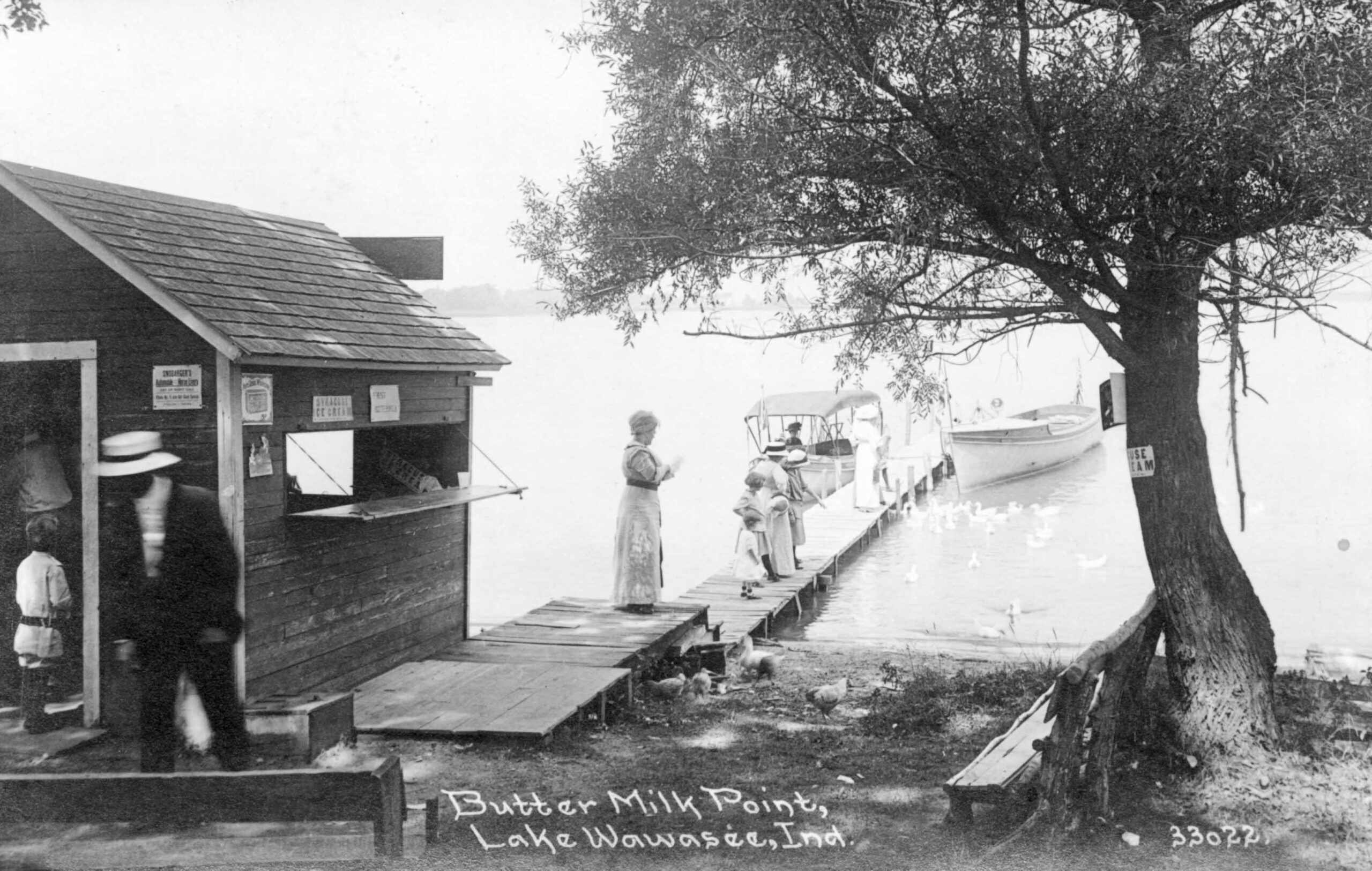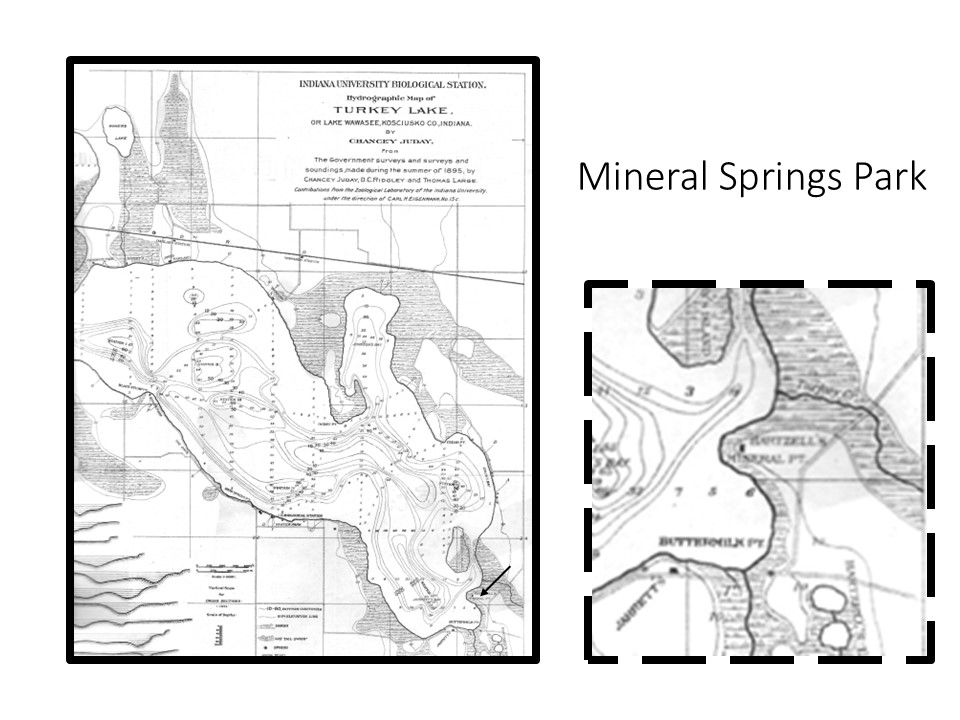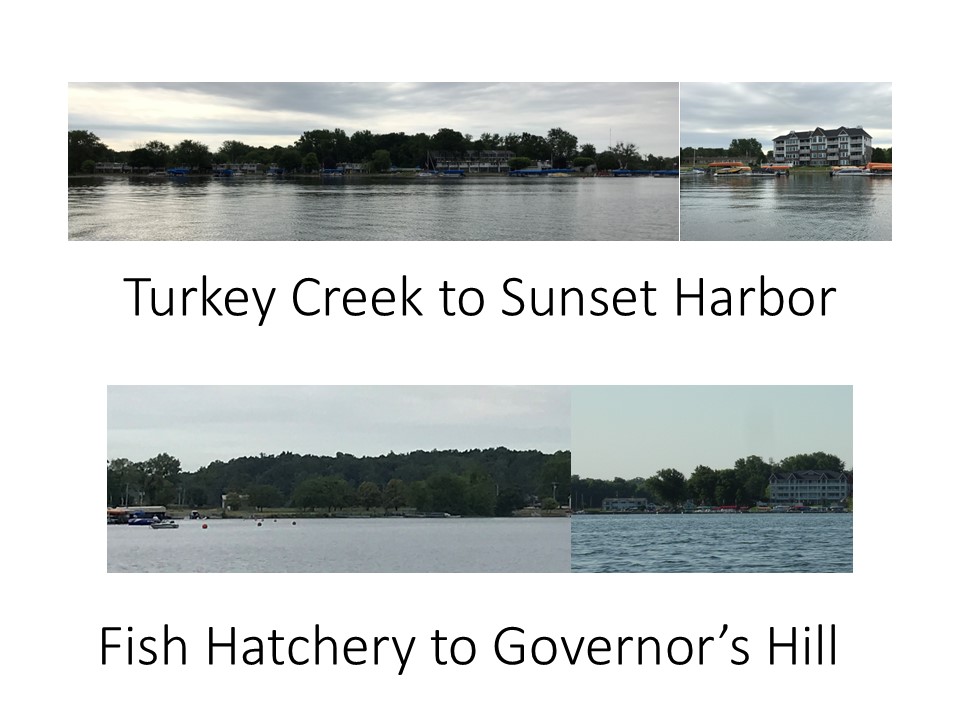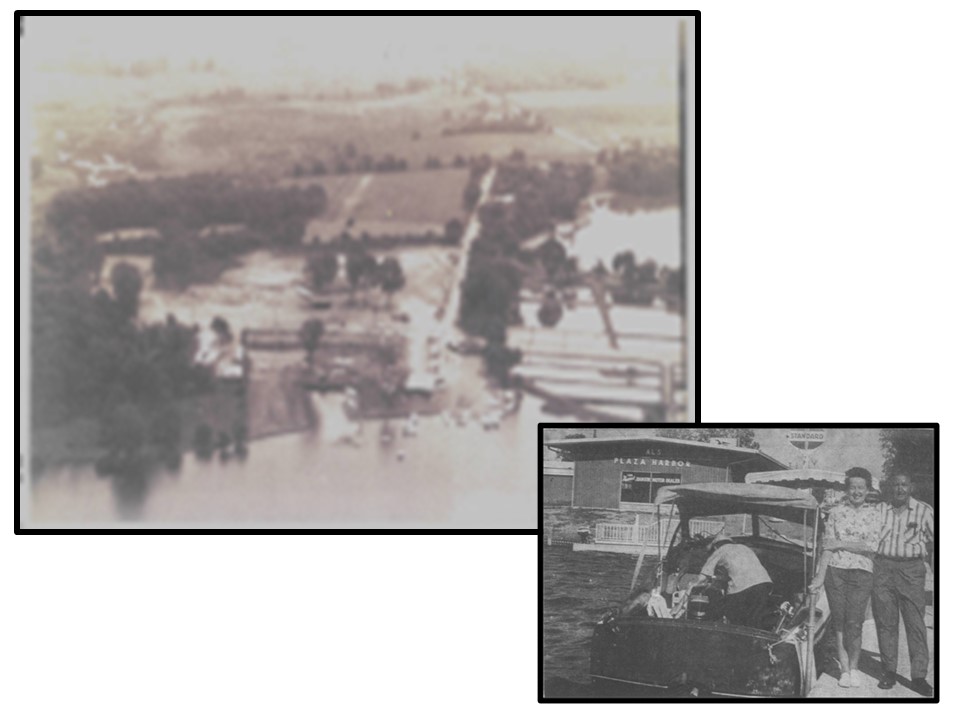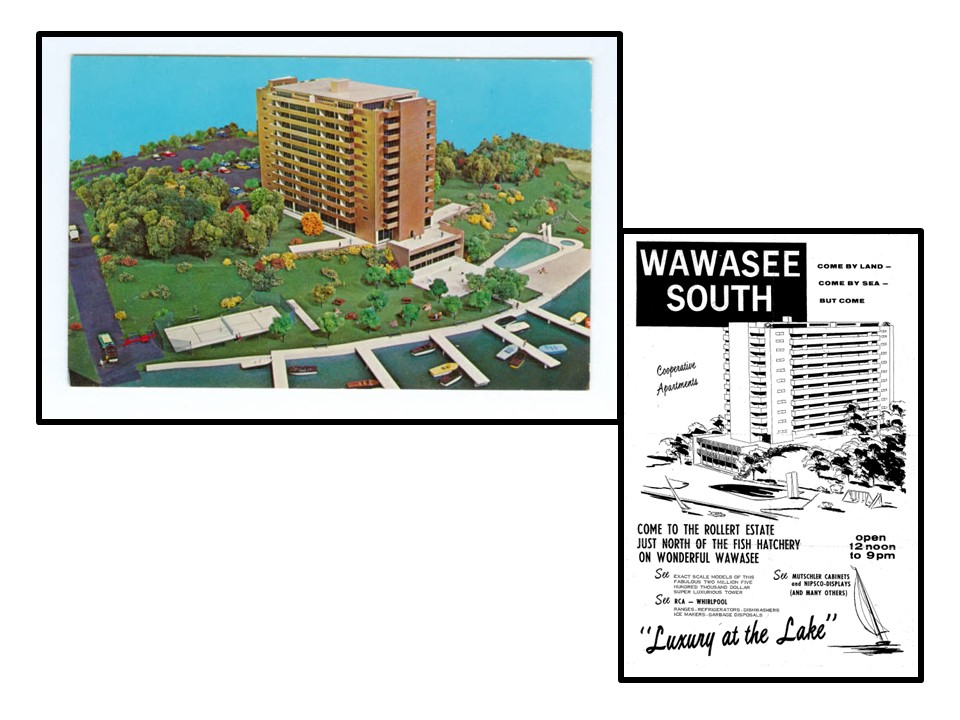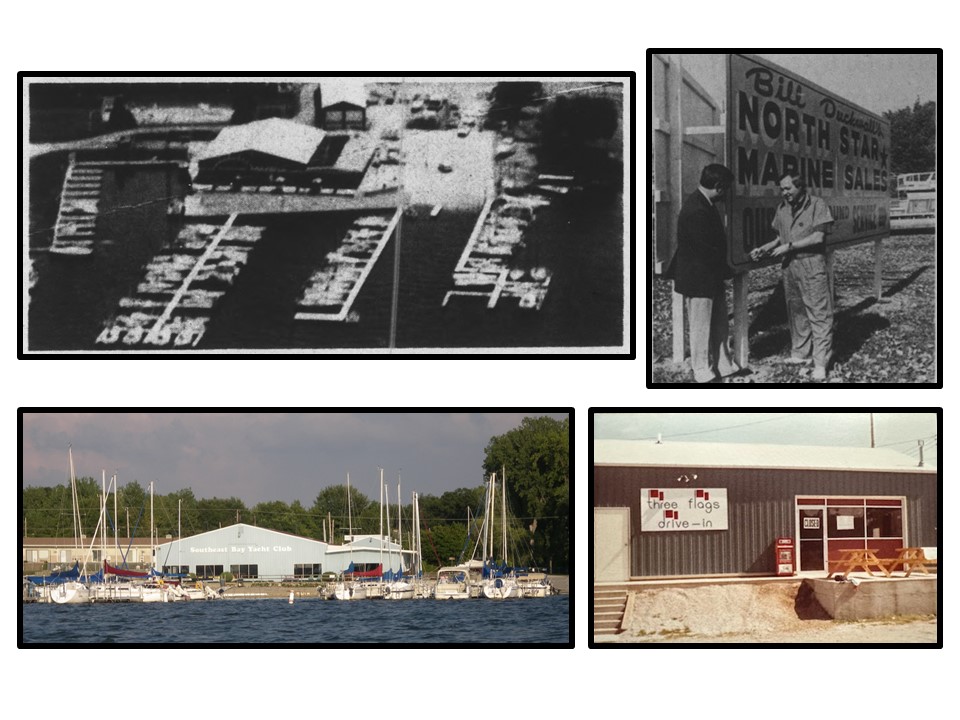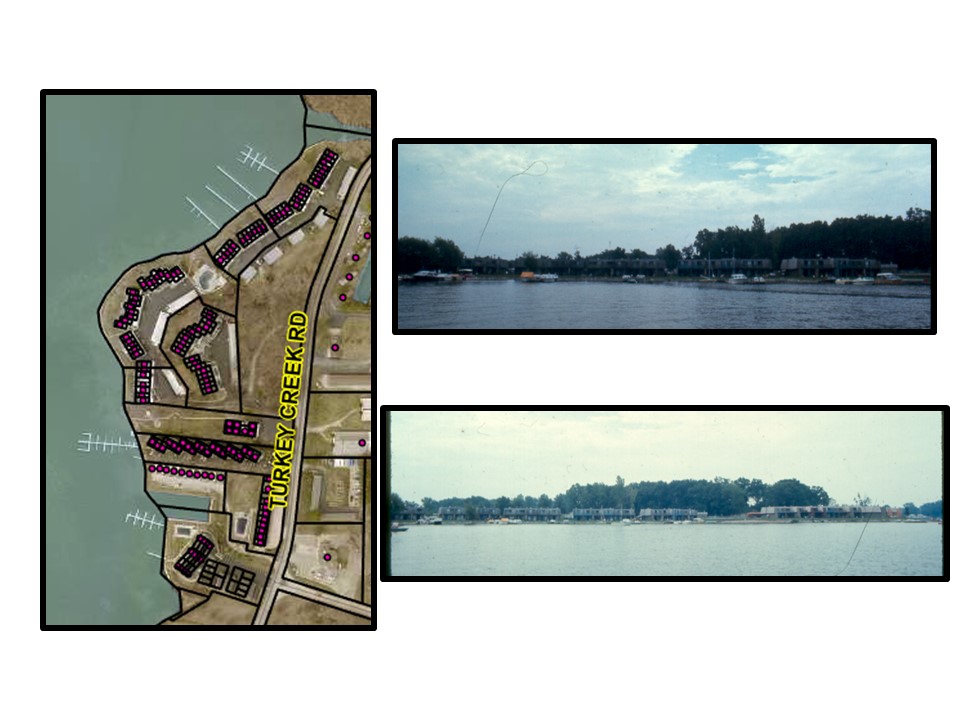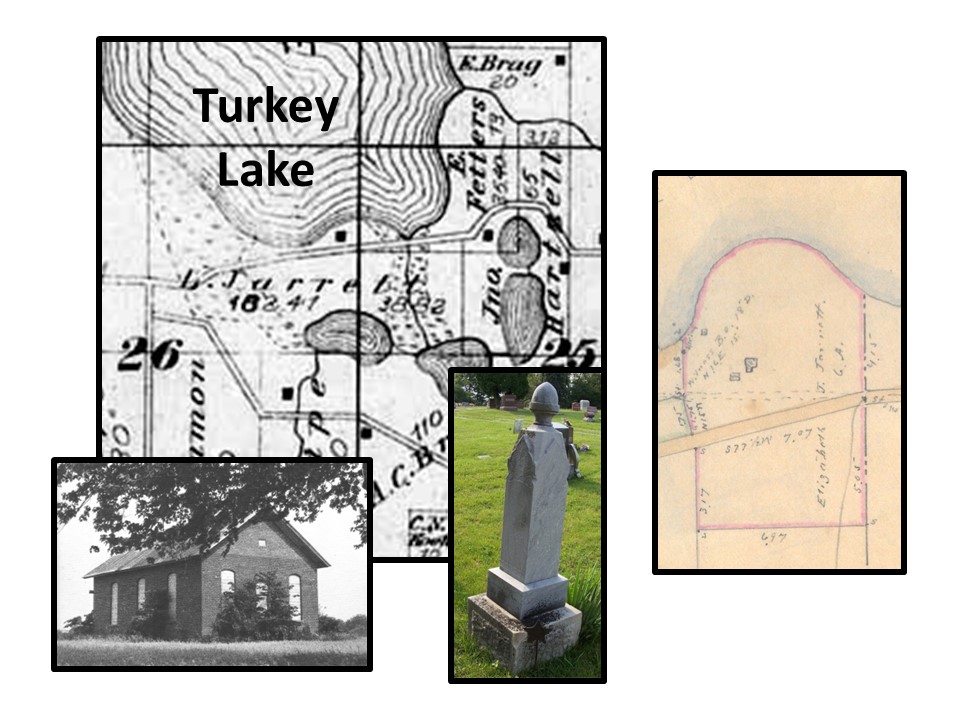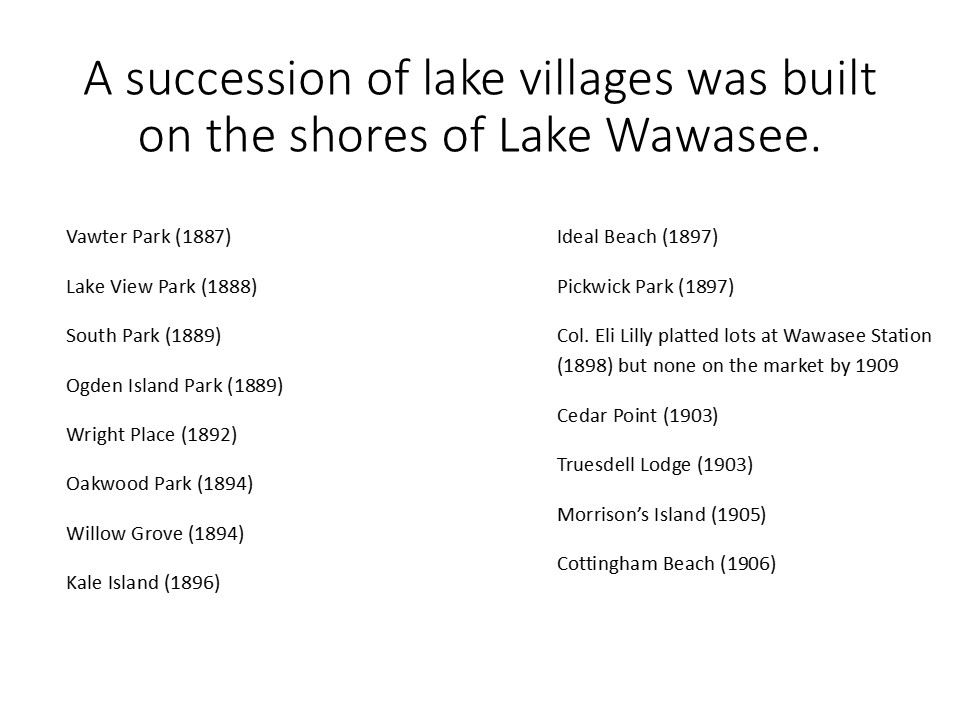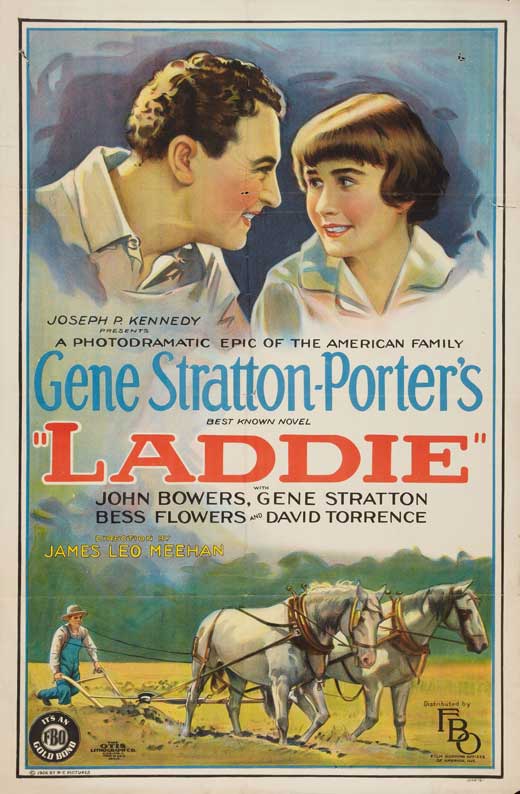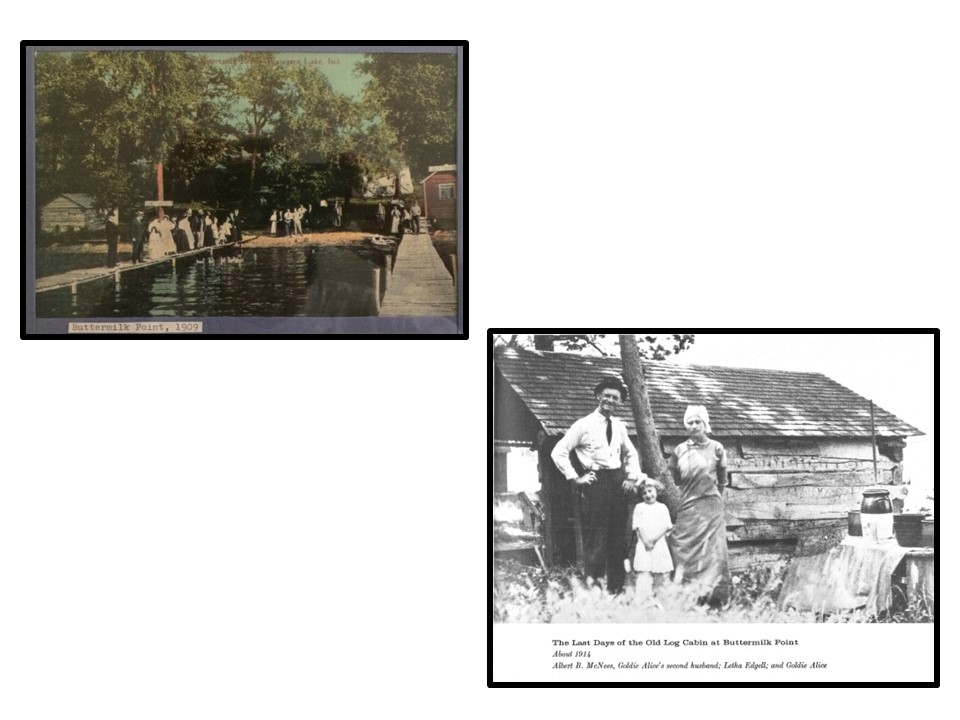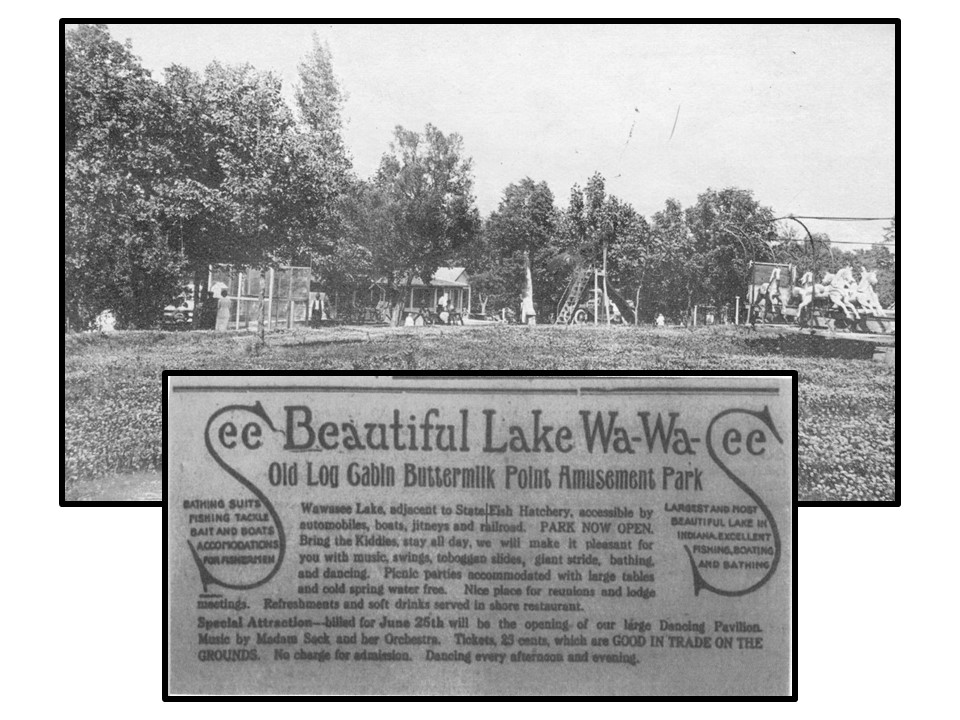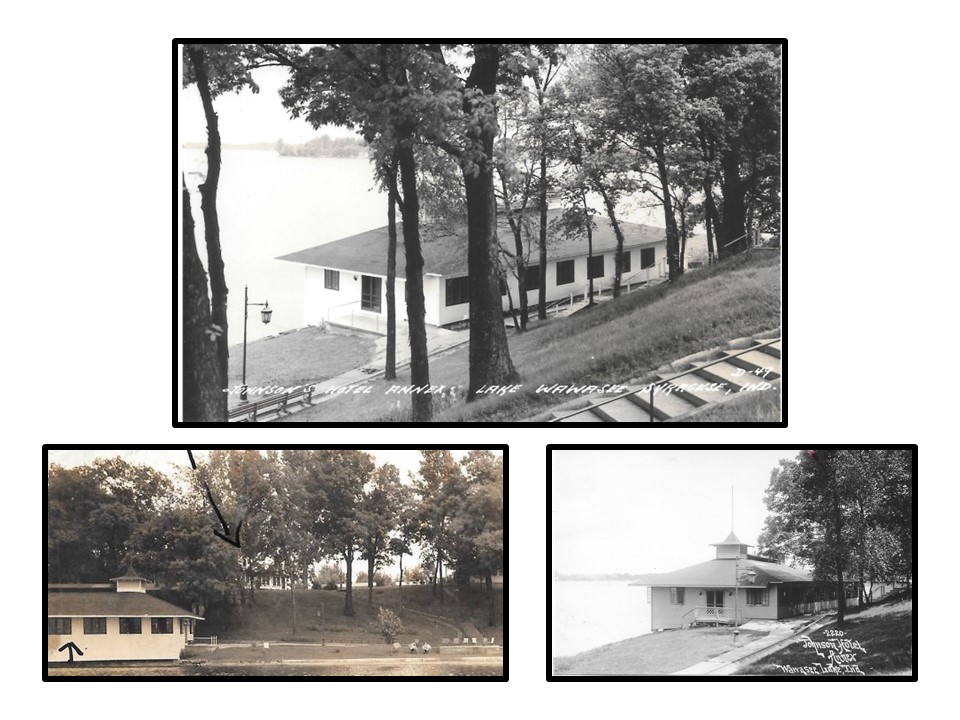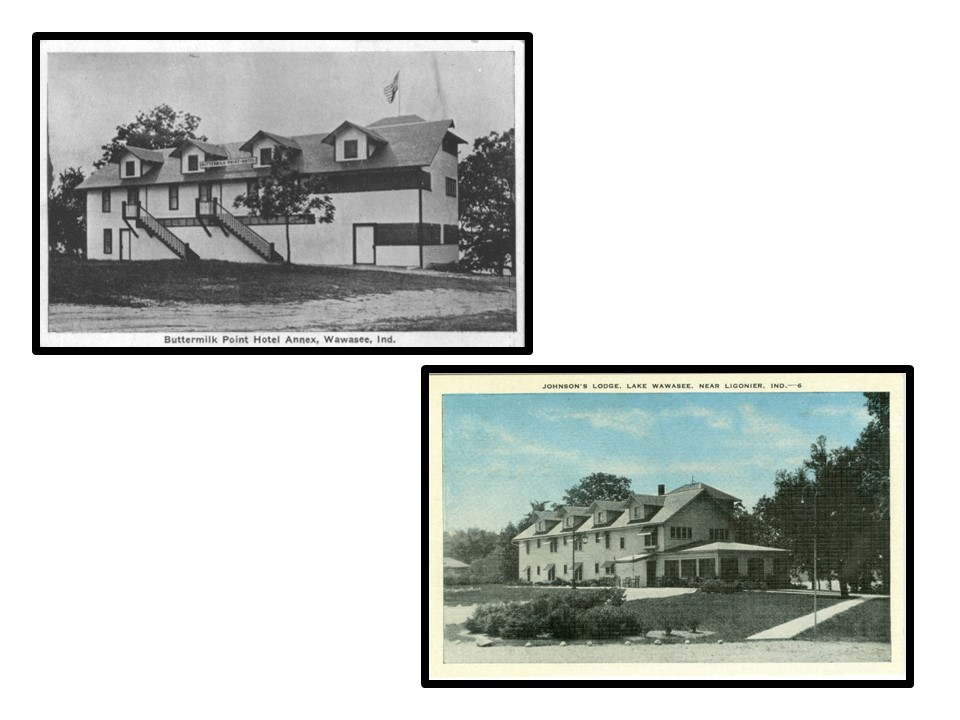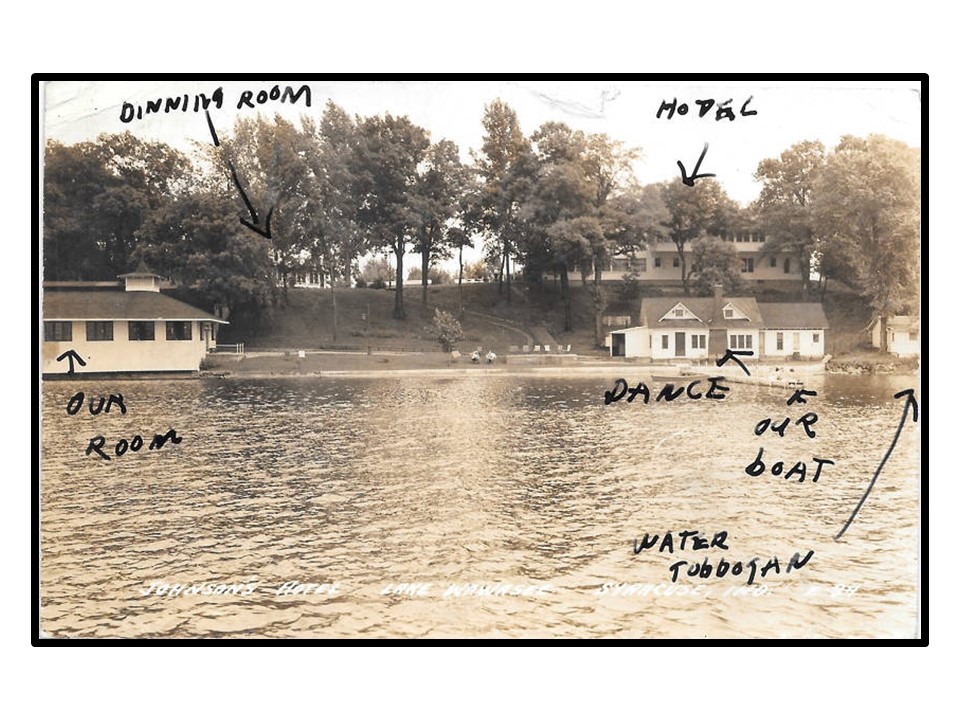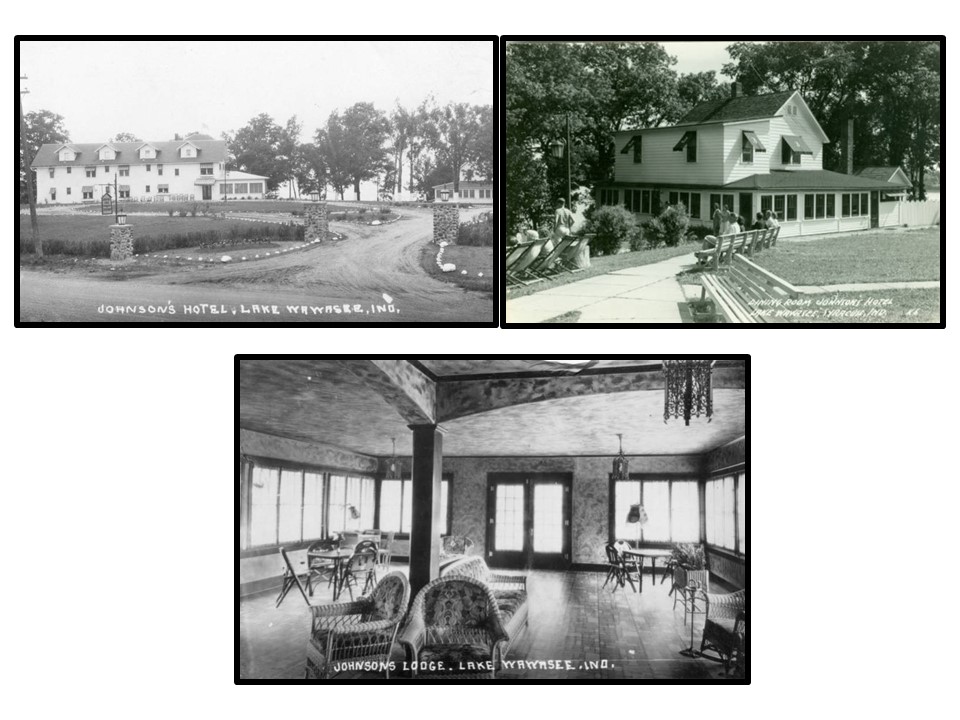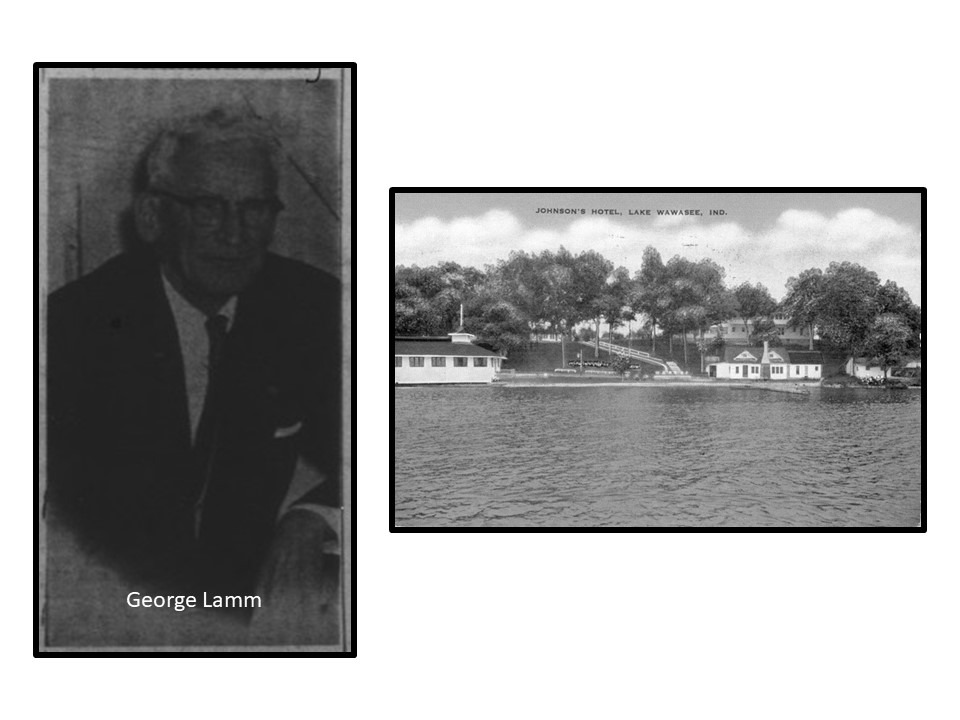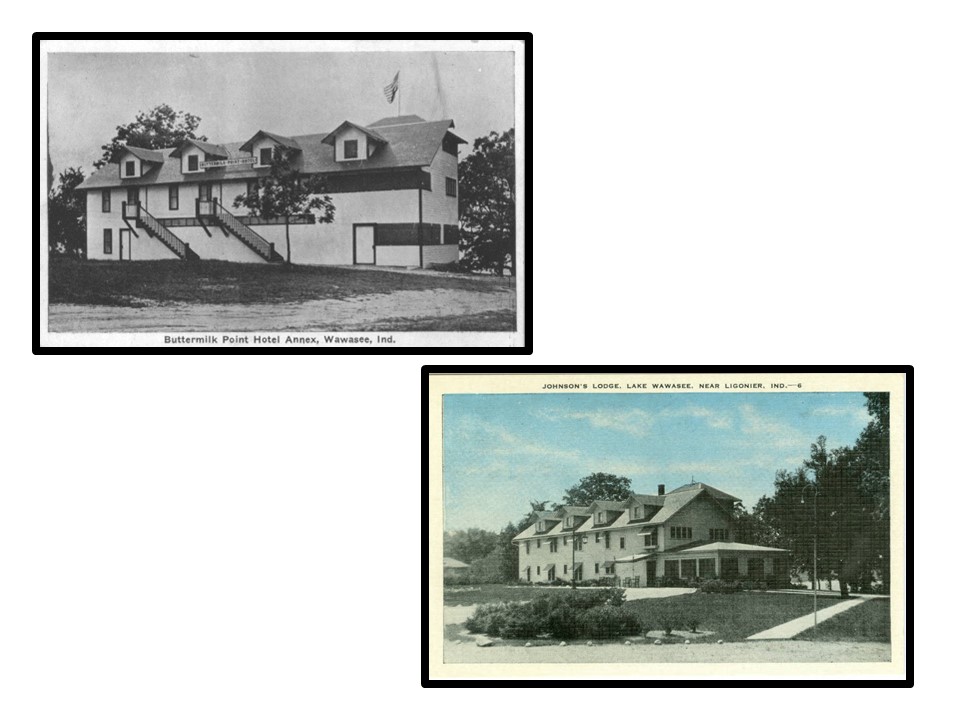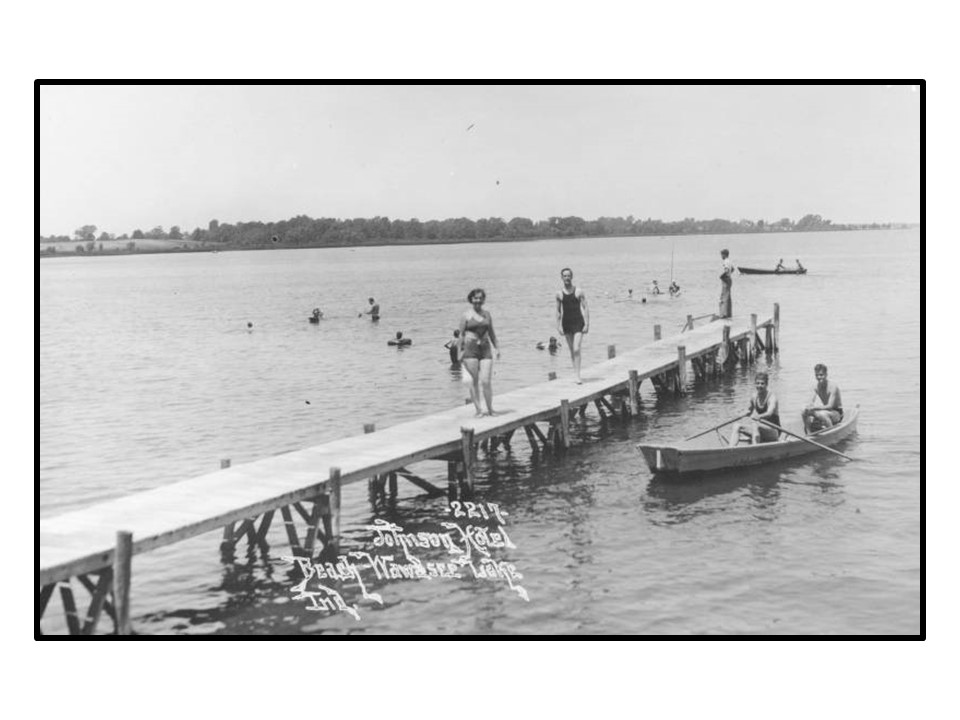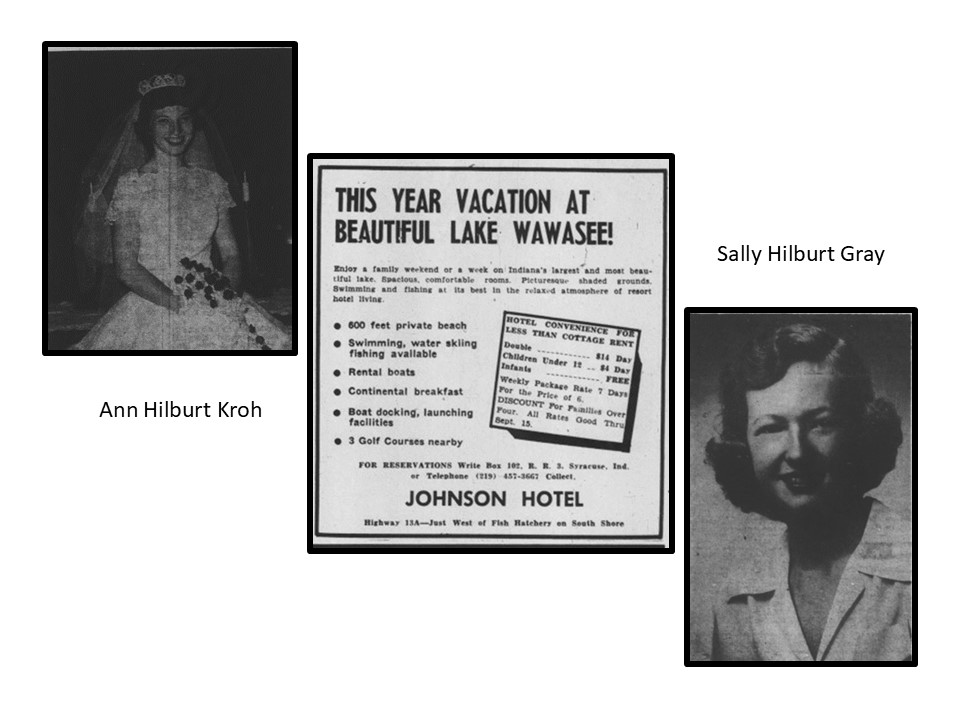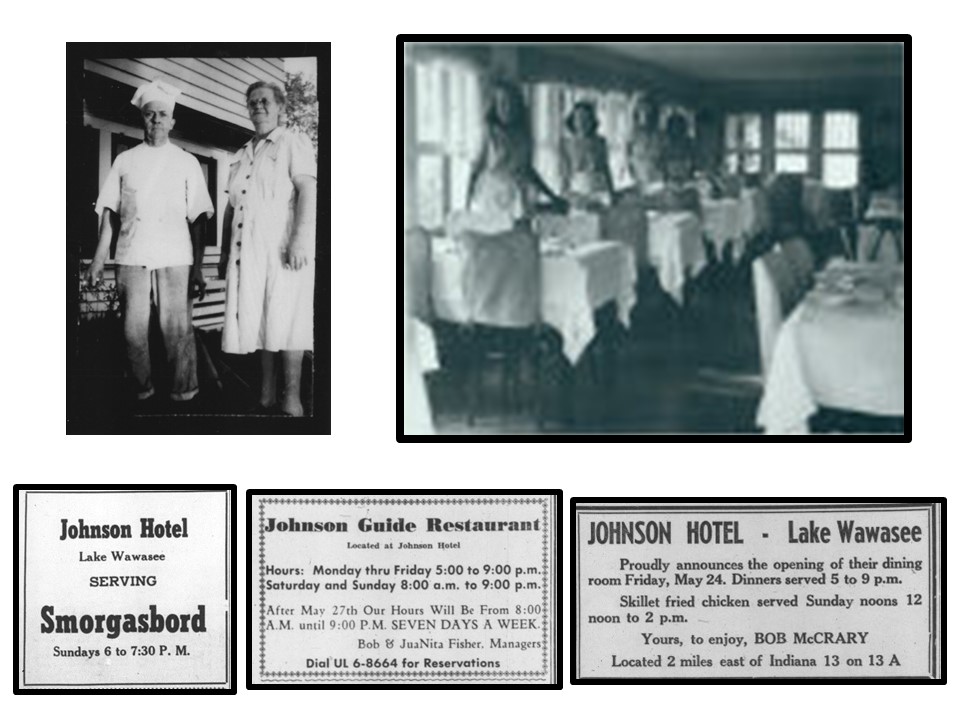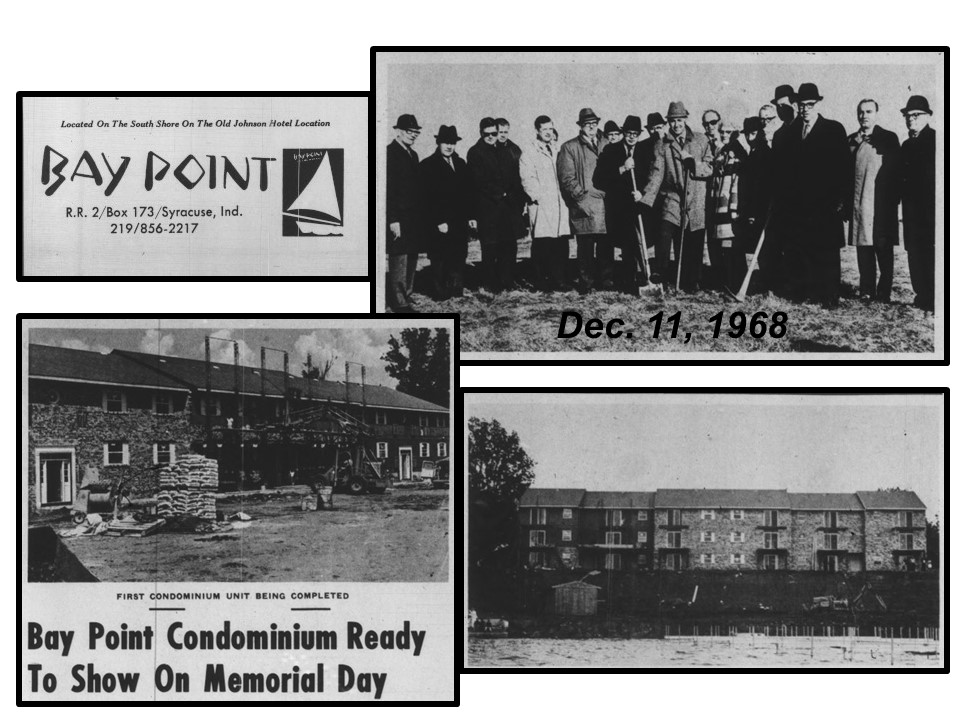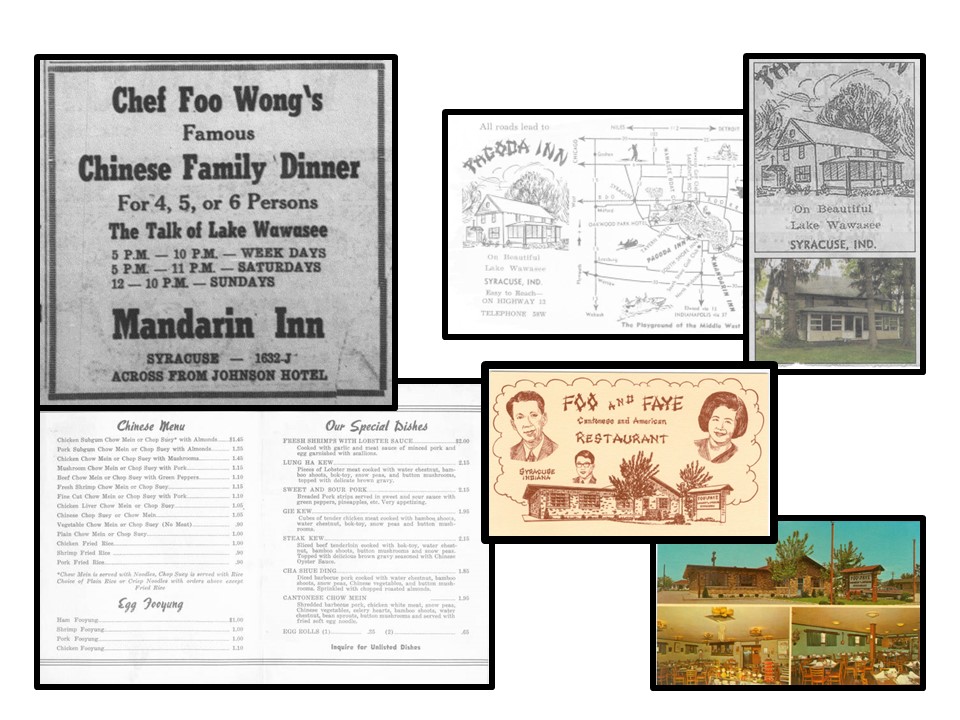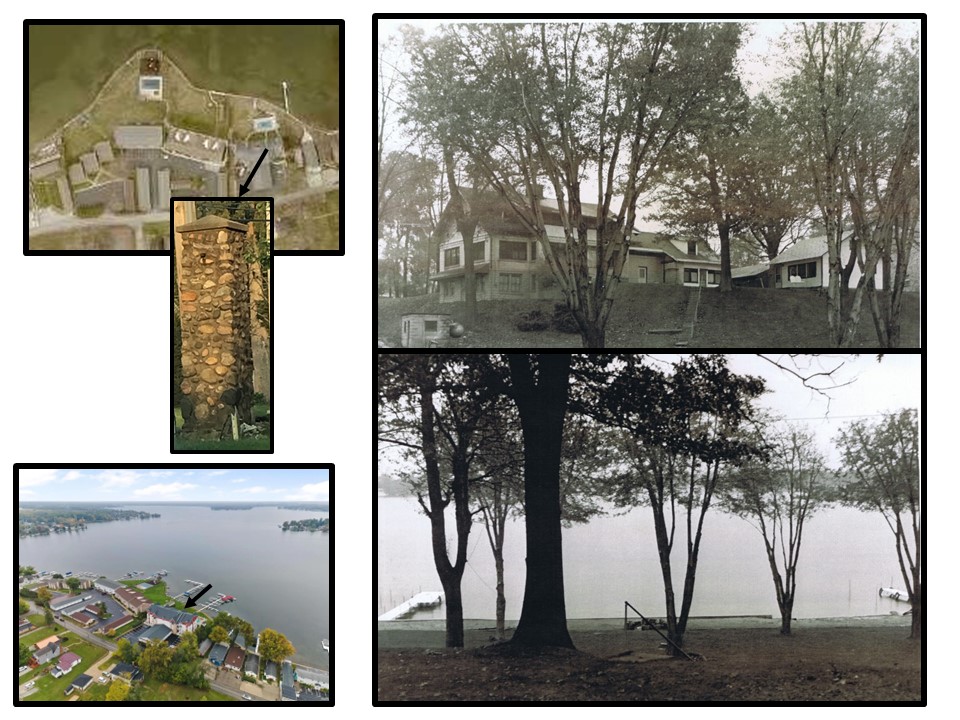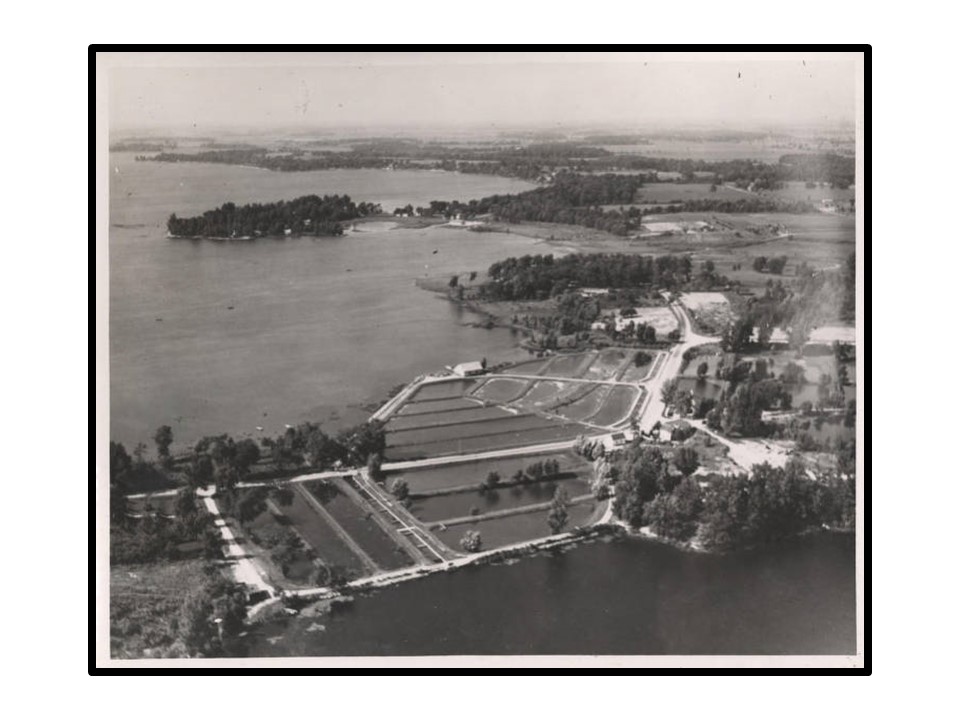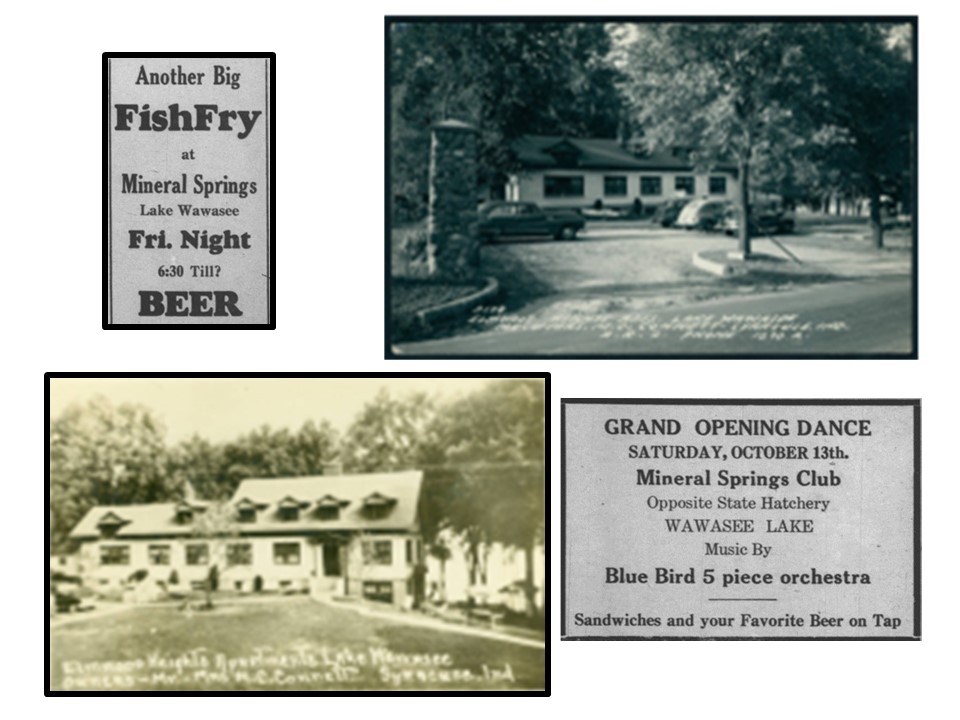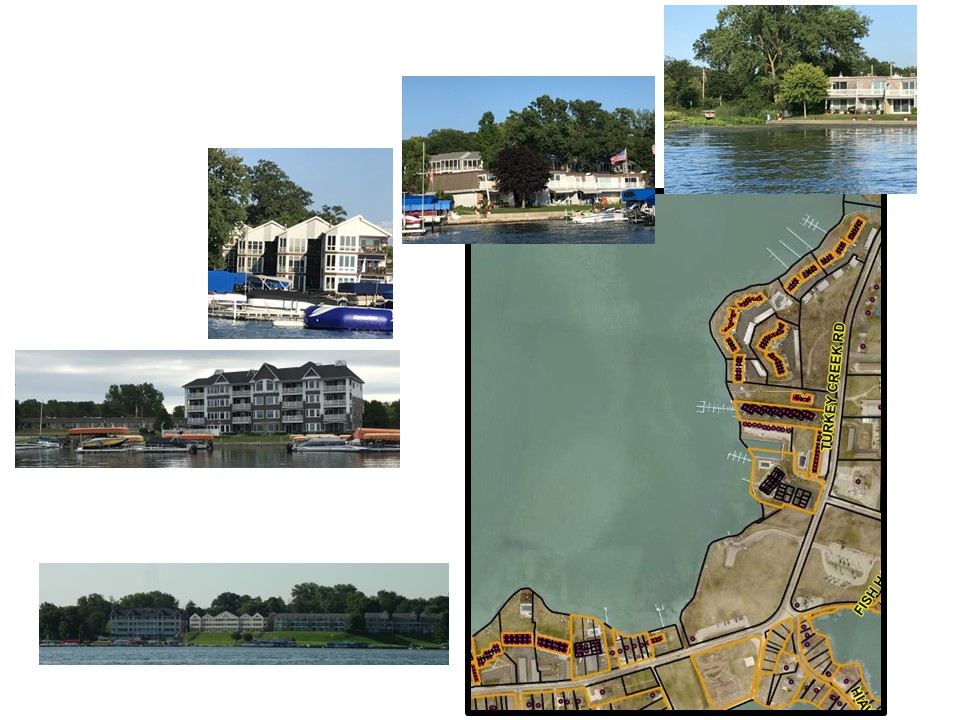From Turkey Creek to Buttermilk Point
A Centennial Presentation – July 2024
A scene from Buttermilk Point
Our story begins on the southeastern shore of present-day Lake Wawasee at the mouth of Turkey Creek. Several mineral springs, prized for their medicinal value, flowed from a beautiful wooded bluff on Chief Papakeechie’s reservation. Mr. Hartzell bought the land in the 1840’s to build a hotel. Around 1895, Mineral Springs Park consisted of a country store, a tavern and an amusement park.

Anton Julius Rollert, a wealthy Chicago factory owner, spent several weeks each summer at Jarrett’s Buttermilk Point around 1897. I’ve been told Rollert loaned a man $800 to get started in business using his woodworking company’s scrap wood; it became Tinker Toys!
As time went by, the Mineral Springs Park property was purchased by Mr. Rollert who converted the buildings into an attractive country estate where he summered. Now it is the wooded overflow parking area behind Runaway Bay Condos; reportedly, bricks from a home built later are sometimes found coming out of the ground. There is evidence of springs in the swimming pool area.

Eventually the Rollert family owned 26 acres of lakefront property from where Turkey Creek enters the lake at Mineral Springs Park, going past the boat ramp area to Elmwood Heights – now Governor’s Hill Condos. In June, 1922, Rollert was building a beautiful large home across the road from the fish hatchery hill. We’ll return to that property later.
During the 1950’s, his grandson had “Bushy” Rollert’s Snackery in the lakeside area at the T near the fish hatchery property. Wintering in Florida for quite some time, Bushy owned a number of restaurants in Miami. Reportedly, he was approached to partner with the owners of McDonalds, but he couldn’t imagine customers wanting such a limited menu as a burger, fries and a drink! Bushy’s Snackery was famous for Key Lime pie & onion rings.
Around 1959, the Rollert family estate was sold to Cromwell businessman, O.W. “Lefty” Martin, who razed the area, built Plaza Marina & Motel which opened in July, 1961, and renovated Bushy’s Snackery to become Plaza Snackery – open year around before it burned in winter, 1962/’63. In 1977, Bushy married Betty Kowallik who had been a third-grade teacher in Syracuse for many years.
In May, 1962, Wawasee South, a multi-story co-operative apartment building with elaborate grounds and recreational facilities was proposed to be built on the Rollert property just north of the Wawasee Plaza. Nothing seems to have come of the proposal.
This property went through several owners as the years went on until in 1981, Doug Anderson, of the Wawasee Boat Co., purchased the Plaza Marina, renaming it Southeast Bay Marina. You could go by boat to get ice cream at the Three Flags restaurant there. Many sleeping-type sailboats were moored at Southeast Bay Yacht Club. The building came down in 2007-08 in preparation to build Sunset Condos.
Starting at the entrance of Turkey Creek (top of picture), Wawasee Condominiums at Mineral Springs Park were built in 1963. In July, 1971, the first stage of Runaway Bay was nearing completion with 108 units planned. In June, 1990, Pier 343 Condominiums (21 units) were under construction. In the early 1900s, this acreage was home to only a handful of families; now that condominiums are built on it, hundreds of families enjoy the lake. Old photos of area were taken by Jim Howard of Syracuse.
Going back in time to the 1840s, Bentley Jarrett traveled from Virginia to settle on the best hunting and fishing land he could find at the southeastern tip of Turkey Lake, as Wawasee was named at the time. The land was near the Africa School, still standing today in the Tri-County Fish and Wildlife Area. His son Lewis acquired the land we know as Buttermilk Point, thus he & his wife Betty were “in on the ground floor” of modern lake history. Civil war veteran Lew Jarrett is buried in the N. Webster Cemetery; Betty is buried in Albion.
With the arrival of the B&O Railroad in 1874, the lake was becoming a resort area. Lake villages began on the southern shore and fingered out from there.
Below the high banks, Lew Jarrett built a log milkhouse cooled by water from a nearby spring flowing around crocks filled with delicious buttermilk, sweet milk and cream. By 1893, landing docks were built for boats, and the milkhouse became famous. Eli Lilly wrote from personal experience: “The steamers all stopped there for rest and a glass of milk or buttermilk at the log cabin, a curiosity in itself, on their way around the lake, their warning whistle bringing Mother Jarrett down the hill – most often in bare feet. Goldie Alice, her lovely blond daughter, often assisted, being no handicap to business.” Jarrett’s Landing soon became known as “Buttermilk Point,” a major source of income for widow Betty Jarrett and her family. She welcomed a few summer boarders in her home and served chicken dinners on a limited basis.
Goldie Alice Jarrett and William Henry Edgell met while students at Syracuse High School. The couple married in 1902, and he became a power plant engineer at the cement plant. They had 3 children before William Edgell was transferred to Kansas; Goldie Alice chose to stay at Buttermilk Point.
Here’s an interesting connection: William Edgell’s older sister, Hattie, married Charles Bowersox making John Bowersox (stage name Bowers) Goldie Alice’s brother-in-law.
In 1909, Betty Jarrett sold the majority of her land to the Northern IN Improvement Co. for their Lake Papakeechie project, keeping the lake-front acreage. After Betty’s death in 1911, her daughter, Goldie Alice, married Albert McNees in 1913, continuing the operation until the 5-acre property with a fine house and barn was sold for $3,000 to Charles Johnson of Indianapolis in 1914. According to his family, “Charlie looked English – very dapper with an impulsive, happy-go-lucky, entrepreneurial spirit.” Minnie, Charles’ wife, was more quiet – definitely German.
In June, 1916, a new era began at Buttermilk Point. To the delight of visitors, Johnson opened the Buttermilk Point Amusement Park, complete with merry go round, dance hall, and zoo – animals were cared for in the old barn and displayed in cages on the side of the bluff. He erected new buildings & unrecognizably remodeled the old Jarrett home at the top of the hill. Chicken dinners were served in a cozy dining room adjoining the house and overlooking the lake.
Charles Johnson hired Goldie Alice & her young family to stay and help run the establishment. The Johnsons continued selling buttermilk and built a bath house, renting bathing suits. As a 12-year-old, Scott Edgell piloted the 40-foot excursion boat and operated the popcorn machine. In 1916, when Scott was ready for high school, the last of the Buttermilk Point Jarretts left the lake and moved to Mishawaka living near old friends.
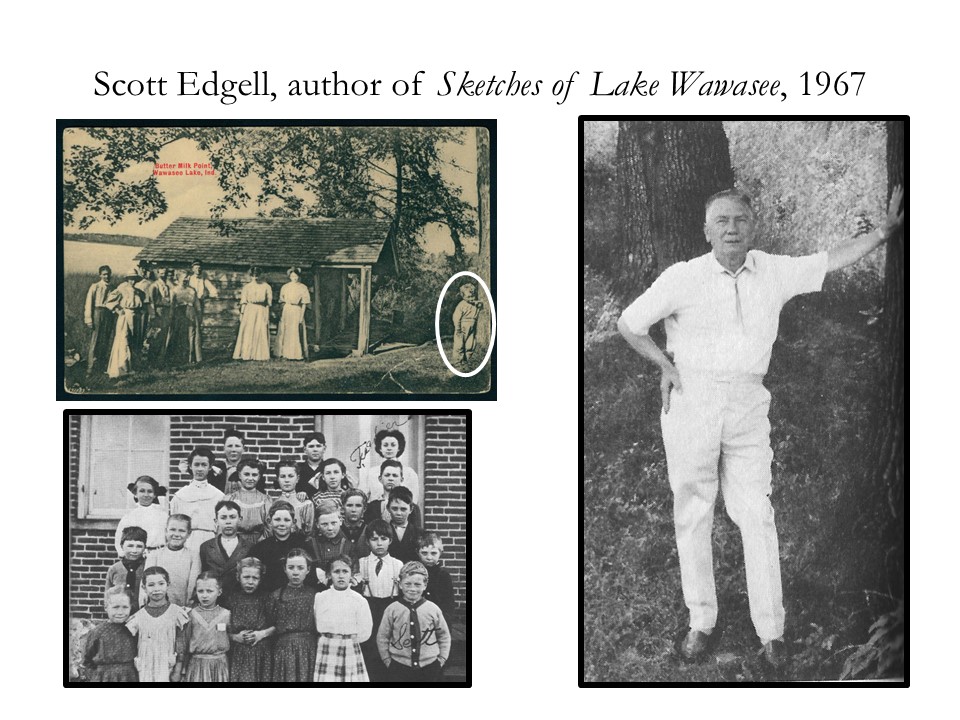
In 1919, Charles Johnson built a large dancing pavilion at the water’s-edge for Friday and Saturday night square dances which in 1929 became The Annex, adding eighteen more sleeping rooms. Ike Klingaman, with his German accent, was the caller for the square dances.
Charles’ son, Walter Johnson, took charge of the property around 1927. According to a letter from his granddaughter, she suspected after his father was gone, Walter shut down the zoo, concentrating on the hotel – most likely upgrading the existing building. He built a large social room and was going to open a “sports club,” the Wawasee Rod & Gun Club.
There were eventually 6 buildings on the property. It was not a money-making venture – in addition to all the outward expenses, you had to make the summer money stretch all winter long.
Johnson’s hotel, on the east side of Lake Wawasee, was particularly noted for its home-like atmosphere. The cool, comfortable lobby of this beautiful little hotel lent peace and quiet to any number of summer visitors. The view from the high bluff, on which the lodge was located, captured the entire east end of the lake, furnishing scenic beauty beyond reproach.
After Walter Johnson died around the late 1930s leaving wife, Maude “Beth,” and a young son, Richard, “Dick,” age 6, George Lamm, a traveling salesman, came into their lives, and he must have never left! The two married and for the next 18 years, “Beth” gladly turned the hotel management and maintenance over to George, so she only had to concentrate on the kitchen in the separate dining hall.
Her son, Dick’s carefree days ended when George arrived – no more lounging at the lake – he was “put to work” to help around the hotel with maintenance and Spring cleaning. Every year Dick had to put in the pier and erect the diving platform pretty much alone as George wouldn’t get in the water.
Dick shared memories with me before his death in 2019: as a bellboy, he answered requests for “Send up a pitcher of ice” by chipping away at a huge hundred-pound block of ice. When Dick was a teen, he “moved up” to working as a bell hop and remembers many a trip up and down the hill’s 77 steps with luggage. He got quite good at badminton and croquet!
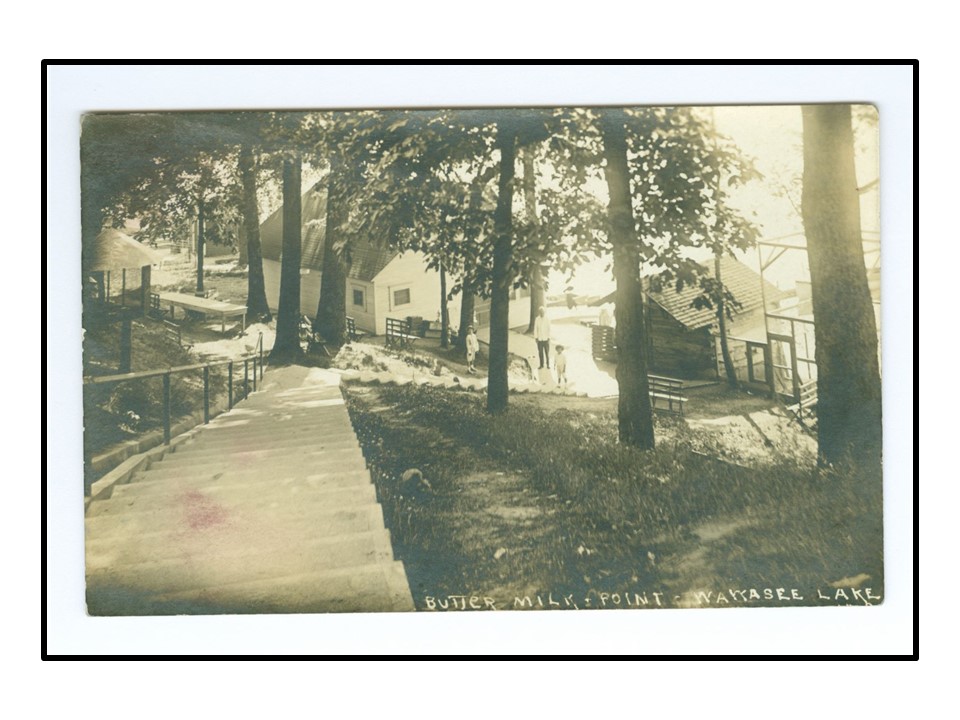
After selling the hotel in 1945, George Lamm went on to become Turkey Creek Township Trustee from 1959 to 1962, and partnered with Roscoe & Berniece Howard to buy farm property creating the Wawasee Village where he and Beth built a home after the hotel was sold; that house still stands today, housing the former Todd Realty and Team Tuttle Mortgage, just south of Calvery UMC.
In Sept., 1945, at the end of World War II, Embury G. “Pete” and Helen Hilburt of Dayton, OH, purchased Johnson’s Hotel with a capacity of about 65 guests, an annex and separate dining hall situated on four acres. They were generally open mid-May thru mid-Sept. offering 600 feet of private beach, continental breakfast, dinner on the grounds and in 1968, charging $14/day for a double room. The Hilburts had four daughters, Ann (left, m. local Tom Kroh), Sally (right, m. summer resident Edgar Dale Gray), Mary and Frances, who assisted in the operation of the hotel. They were familiar with the area because Pete Hilburt’s father had owned a cottage just across Hatchery Road from nearby Cottingham Beach since the early 1930s.
A variety of dinners were offered to entice the public: Sunday evening smorgasbords (‘48, ’49); in 1961, owners of Guide restaurant managed the hotel dining room as well as keeping the Guide open; and in the summer of 1963, Bob McCrary offered “Skillet fried chicken served Sunday noon to 2 p.m.;” Chef Baxter is pictured; Steve Dodds was another chef at the hotel.
Negotiations to sell the hotel property began in the early 1960s, but it wasn’t until the summer of 1968, that construction on Bay Point Condominiums began, starting from the east edge of the property, in three phases while Johnson’s Hotel remained in operation.
Bay Point was Indiana’s first condominium apartment complex designed for luxury living at a lake resort. Situated 18 feet above lake level, each apartment in the three-level buildings faces the lake commanding a northwesterly, seven – mile view. The complex purchased the sewage treatment facilities already in use at Enchanted Hills and extended a 9,000-foot sewer line from the development. The first occupants moved in in July, 1969. Johnson’s Hotel remained in operation for a couple more years until the building and its remaining contents were auctioned on Aug. 14, 1971, and the building was torn down in preparation for the third condo building.
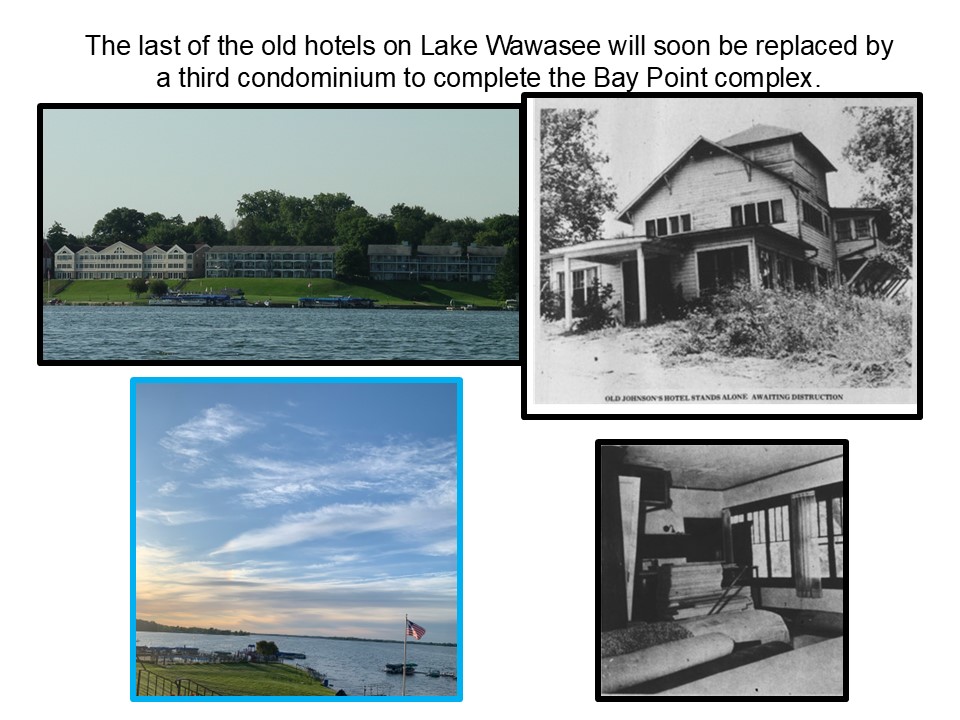
Across the road from Johnson’s Hotel, the Mandarin Inn opened in the summer of 1947 – 2024, a chain link fence surrounds area. Owner Charley Chin brought the recently married Foo and Faye Wong to the area from Seattle, WA. Charley was gone a lot, so Foo and Faye ran the restaurant. In 1952, the Pagoda Inn on South Shore Drive was opened in the former Marine Club building. It housed the Italian Villa by at least summer 1957. Foo & Faye’s restaurant in the Wawasee Village started in 1954, serving delicious Cantonese and American food to as many as 1,000 customers a day on Mothers’ Day thru the mid-1970s.
Later, on the Mandarin Inn site across from the Johnson Hotel, was the Casablanca restaurant – summer, 1954. Then around 1956, the Hickory Pit – barbequing ribs, chicken, hams, & beef – was in business during the summer months. After a fire, it was completely torn down in 1958.
To the east of Johnson’s Hotel, was Elmwood Heights (now site of Governor’s Hill condos). In June, 1922, J. Rollert, the Chicago woodworking factory owner we met before at Mineral Springs Park, was building a beautiful lodge with big rooms and beautiful woodwork entered through two entrances built of stone with iron gates to around 150 feet of lake frontage.
By 1930, area residents were asking that the fish hatchery be enlarged. The Syracuse Journal, Oct. 11, 1934, reported: Anton J. Rollert and wife, Katy, sold an 83×588 ft. tract of lakefront property to the State of Indiana for $1.00. Seven or eight fish ponds will likely be built on this land, and an island in Wawasee adjoining this property is to be beautified by the CCC camp.
By 1930, area residents were asking that the fish hatchery be enlarged. The Syracuse Journal, Oct. 11, 1934, reported: Anton J. Rollert and wife, Katy, sold an 83×588 ft. tract of lakefront property to the State of Indiana for $1.00. Seven or eight fish ponds will likely be built on this land, and an island in Wawasee adjoining this property is to be beautified by the CCC camp.
Governors Hill Condominiums were built on the site of Elmwood Heights. The four-story building with 11 living units, marketed by Harlan Steffen Realty, was completed 3/30/2005.
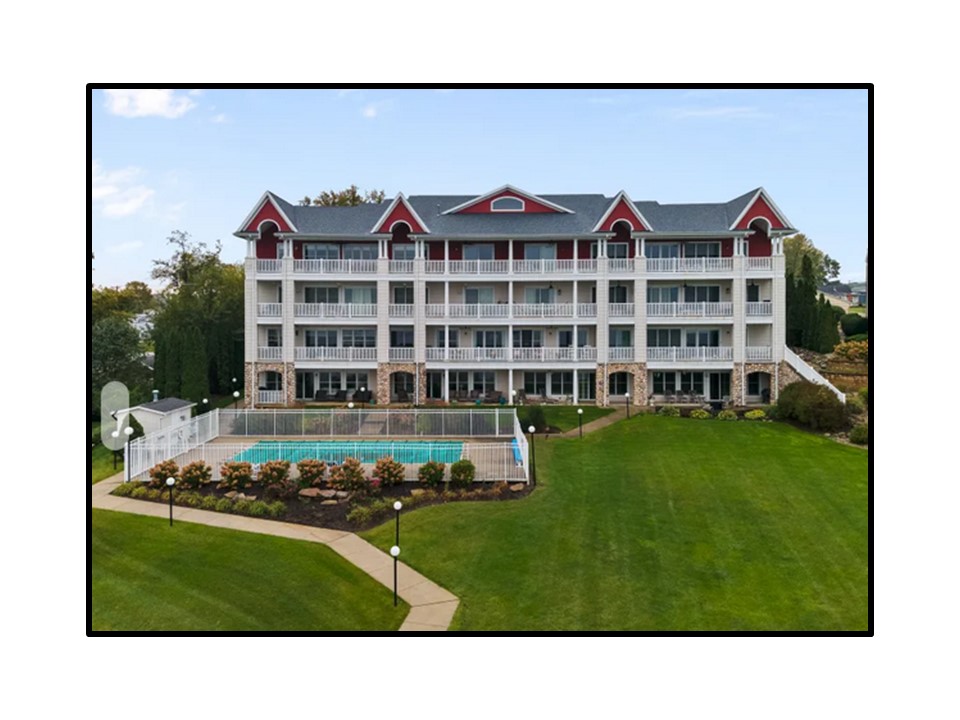
Originally from the entrance of Turkey Creek into Lake Wawasee to Governor’s Hill Condos was all Rollert property, and the Bay Point Condominium complex was Jarrett property. What long ago was home to just a few is now enjoyed by a large number of families!
